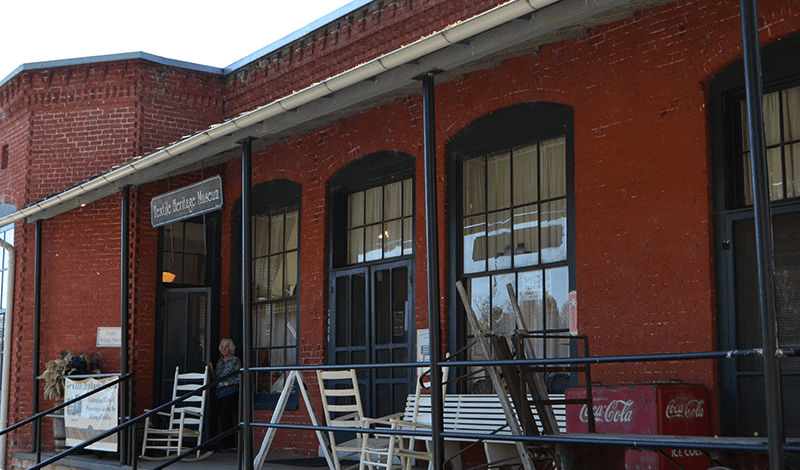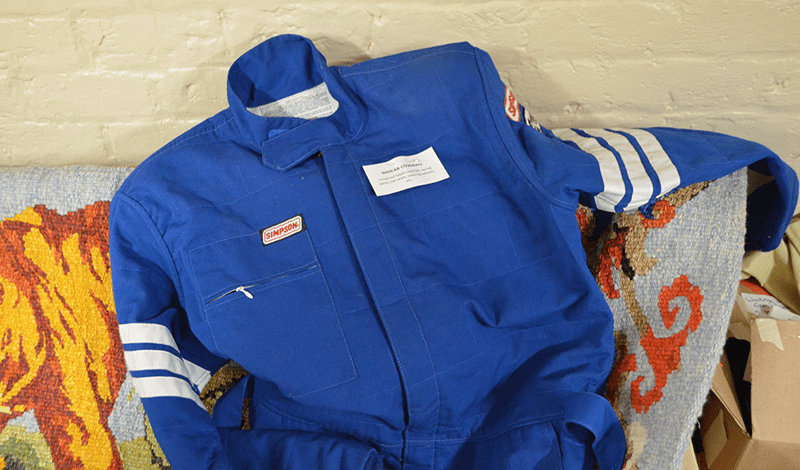
UNC System Institutions Help Uncover NC Histories
Every North Carolinian inhabits a haunted landscape. Our ghosts don’t rattle chains. Objects don’t dance when the clock strikes midnight. But we live in a state where past and present intermingle. ‘History’ isn’t gone … it’s with us in the here and now, appearing in ways that we don’t even recognize or appreciate.
Anyone who’s ever used “fair to middling” to describe a frame of mind has experienced a haunting. At one time, this was the common parlance used to evaluate the quality of cotton. Today, North Carolinians utter the phrase completely unaware of its origin. It is a linguistic specter of the state’s textile heritage.
It doesn’t take an Ouija board to bring this apparition into plain sight. Just look carefully at the flat file cabinet now standing tall at the Textile Heritage Museum in Glencoe Mill Village. There you’ll see a label that reads, “middling fair,” perched midway down on the stack of drawers that once stored Glencoe Mill cotton samples, organized from top to bottom according to quality.
The Textile Heritage Museum is just one of the countless sites across the state dedicated to preserving North Carolina’s rich cultural history. Obsessed with the fabric woven into North Carolina history, Jerrie Nall and Kathy Barry founded the museum as a labor of love—and they turned to the UNC System at the critical junctures when they needed help. NC State, UNC-Chapel Hill, and UNC Greensboro have all supplied resources and materials that have helped turn what began as a makeshift endeavor into a significant regional attraction and a state-wide resource.
This isn’t a unique tale, either. Across the state, UNC System institutions provoke dialogue with the ghosts of North Carolina’s past. Yes, these encounters happen in classrooms and in books, between faculty and students. But UNC System research and engagement impacts every region of the state in other ways, bringing all North Carolinians into close contact with bygone eras.
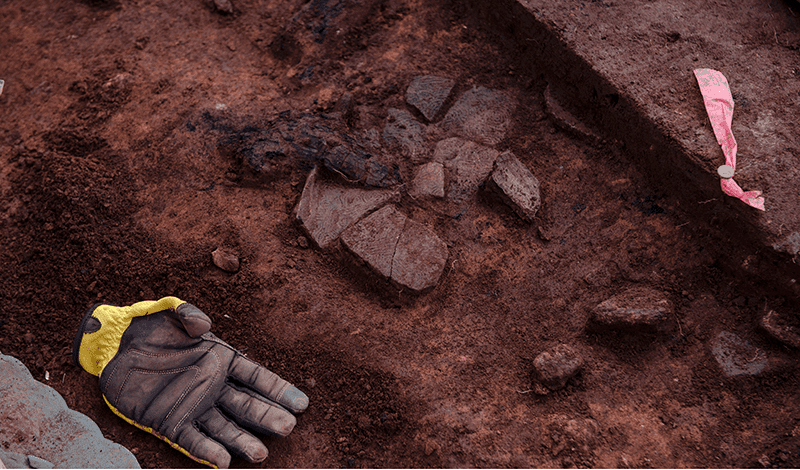


What’s Under the Rug: Groundbreaking Work in Archeology at Western Carolina University
“I love the movie,” chuckled Dr. Jane Eastman, associate professor in Western Carolina’s Department of Anthropology and Sociology. “But if Indiana Jones were a real archeologist, he would’ve died in the first scene in Raiders of the Lost Ark, with a 1,000 darts in his rear end. He’d have been too busy bending over and taking notes rather than snatching objects from hidden tombs!”
Dr. Eastman’s impromptu film criticism succinctly captures what makes her work so challenging … and so urgent. WCU’s archeological team is committed to unearthing, documenting, and deciphering Cherokee history, and it has one chance to get it right.
“We have to be very careful to document every step. In all honesty, excavation is one of the most thorough ways to destroy a site. We get one chance to document it. If we blow it, it’s gone forever,” Eastman said.
Dr. Eastman, Sequoyah Distinguished Professor of Cherokee Studies Brett Riggs, and Director of Cherokee Studies Ben Steere are the core archeological faculty members in Western Carolina University’s Cherokee Studies Program. Together, they have dedicated themselves to excavating a history that permeates the Cullowhee landscape.
Today, state-of-the-art science facilities, vibrant residence halls, modernist buildings with ground-to-ceiling glass walls, and more than 11,000 students spread across a terrain that was once home to a Cherokee settlement called Tali Tsisgwayahi—“Two Sparrows Town.”
WCU is growing, and before any new building goes up—or even before a stretch of cable goes down— archeology faculty and students dig into the meticulous work of recovering, cataloging, and studying the artifacts underfoot. They certainly have lots to find; in the past three years alone, there have been five active dig sites on campus. Teams have uncovered everything from stone tools dating back to the Archaic Period in 5000 BC to remnants of houses from the eighteenth century. The institution’s history begins in 1888, but the area where campus now sits has been occupied for millennia.
For Steere, the study of architectural history has the firmest grip on his imagination. Dark stains in the soil, 10-20 centimeters across, can mark where postholes were once dug into the ground to form the foundation of a structure.
“Those stains are almost like an architect’s blueprint for a house,” explained Steere. “We can determine the shape of the house. Sometimes we can find smaller stains inside, which would have been supports for furniture and interior walls.”
These spectral architectural footprints date as far back as 1100 AD, and these discoveries are shedding new light on the development of Cherokee domestic culture. Archeological understanding of what Cherokee houses looked like from the 1100s to the 1500s had been murky, but Steere’s research is changing that. And, as the understanding of architectural design comes into sharper focus, so too does our comprehension of social interaction and patterns of social change.
“The way you build your house says a lot about your social relations and how you connect with others across the region. Studying architecture can help us understand whether a community was engaged in a culture of exchange with other communities, or a more regionalized architectural pattern could suggest that members of a community were more hunkered down,” he explained.
While Steere is more interested in learning about the houses where people lived, Dr. Eastman is captivated by the question of why people would have settled in the area in the first place. Tali Tsisgwayahi, situated in a smaller valley set off to the side of the central Cullowhee Valley, was organized around a ceremonial mound. Many decades ago, the mound was bulldozed, but at one time it was the focal point of the area’s spiritual and communal activity.
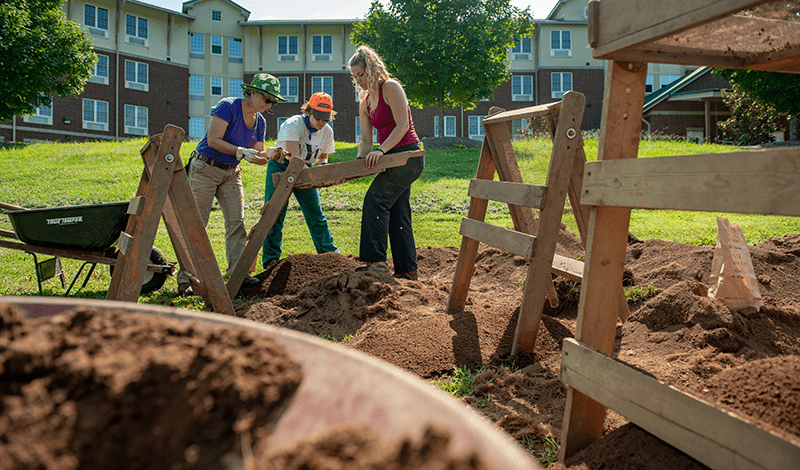
Practical determinants made this setting a logical choice. The smaller valley afforded easy access to water, a diverse habitat, and a sloping gradient that created a natural, easy pathway from the town to the mound.
But Eastman is just as interested in the cosmological function of this terrain. Today, we think about how users interface with their computers—how screens can be designed to facilitate ease of use and to redirect how people think. Centuries ago, people interfaced with the natural world. Geographical features once played a critical role in shaping the spiritual connection to the landscape. Archeologists call the study of this interaction “phenomenology.”
“Now, when most people stand in the middle of campus, they can’t really get a sense of the landscape or how the contours fit with one another, because there are buildings everywhere. Today we alter the landscape to make room for these buildings,” she explained. “But as Tali Tsisgwayahi developed, the landscape would have figured into the decisions about where to put the mound, not just in terms of resources but in terms of Cherokee cosmology. The features of landscapes are different entities in and of themselves. The landscape wasn’t merely a backdrop. It was an active place that figured – and still does figure – dramatically in the lives of the Cherokee people.”
For instance, in Cherokee cosmology, rivers and springs are pathways to other realms. With the town area surrounded by flowing water on all four sides, residents didn’t just have easy access to drinking water—they had a more intimate connection to those non-Earthly spaces. In Cherokee mythologies and stories, elevated areas are associated with power. Tellingly, the natural line of sight for visitors entering Tali Tsisgwayahi from the main Cullowhee Valley would have been directed toward the mound in the background, towering over its surroundings.
Dr. Brett Riggs also contributes to the excavational work taking place on campus, but he is particularly invested in creating a more complete portrait the Trail of Tears as a historical event with long-term consequences.
In the summer of 1838 alone, more than 3,000 people trudged across the Unicoi Turnpike. Forcibly removed from their homes in southwest North Carolina and neighboring states, they were driven to a designated “Indian Territory” west of the Mississippi. Riggs is helping to compile information about every site associated with this tragic event in American history: the location of the orchards, fields, houses, churches, and schools the Cherokee Nation was forced to abandon, and the many milestones along the way.
Although some portions of the Unicoi Turnpike remain, others have been lost to time. Part of Riggs’ work involves reconstructing the original route using surveys of roads and trails maintained by the US Army Corps of Topographical Engineers at the time. Riggs and his partners in the US Forest Service are geotagging a dense collection of photographs of key locations along the original route and linking them to the historical road surveys.
The end result will be an interactive map that will give users a thorough portrait of the historical route and its current condition. As users survey they map, they will be able “land into” any location on the map and experience that landscape. The multimedia experience will link past and present, making history more tangible, immediate, and accessible.
Riggs is also helping to design a virtual reality experience that will allow users to enter into the fort where all the Cherokee stayed on their way west. Although the rendering will be digital, it will be based on extensive archeological research.
Riggs’ goal is to help users see that this story is integral to North Carolina’s story. The event isn’t distant and removed from our present. The Trail of Tears is still with us and shapes our experience in unexpected ways.
“We understand the outlines of the episode. We understand it in the abstract. The work we are doing will help us understand it in terms of the experience of individual family and community– it becomes a much more intimate human phenomenon,” Riggs said. “It then provides some very provocative lessons that we need to learn.”
The benefits of WCU’s archeological work are multiple. It helps the university meet federal and state compliance in terms of taking care of valuable archeological resources on campus. The work gives WCU students experiential learning opportunities. It provides invaluable historical information and contributes to the tribe’s promotion of its cultural heritage as integral to the state’s identity. And it has opened the door for potentially transformative outreach opportunities. WCU regularly gives students from Swain County schools tours of the archeological digs on campus. Many of these students are members of the Eastern Band of the Cherokee Nation, who have a one in seven chance of being related to the ancestors who built these communities.
“What is really rewarding to me now is that I’m able to bring this information about landscapes and settlements to the descendants of those folk,” explained Riggs. “Just recently we had visitors from Oklahoma who wanted to know where their ancestors lived, and we were able to say, ‘Right here. This is your old homeplace. This is what it looked like.’”
Eastman, Riggs, and Steere might have different research specializations, but this experience of putting past and present in touch with one another is a shared passion.
“It’s important that we continue to conceptualize WCU as a Cherokee place, as a Cherokee community–not just in the past but in the present. Archeological records are one way to do this, because the materials are resilient,” explained Steere.
For years, fragments of history lingered in foggy memories, oral histories, and rituals. Archeological research is making these ghostly fragments more tangible, helping North Carolinians to get a fuller picture of history – and to understand that the past isn’t gone.
“We’ve worked really hard for the past ten years to change the perception of this area. We don’t want people to think that was a Cherokee place. It is a Cherokee place. The university is just the most recent thing that has happened on this land,” said Dr. Eastman. “We’re trying to build awareness of the fact that there are thousands of years of history right here—and it’s still here.”



Putting Maritime History on Terra Firma
On the opposite end of the state, quite a different historical figure haunts North Carolina’s collective imagination. Public fascination with Edward Teach has lingered unabated since he began storming ships, under a much more well-known moniker: “Blackbeard.”
In 1717, Blackbeard captured a French slave-trading vessel. After rechristening La Concorde as Queen Anne’s Revenge, Blackbeard didn’t just disrupt North American and Caribbean shipping lanes; for over a year, he terrorized them. Blackbeard famously transformed himself into a phantasmagorical figure to intimidate other sailors, going into attack mode with flaming candles woven into his thick facial mane.
Two centuries later, in 1996, divers discovered the remains of Queen Anne’s Revenge near Beaufort Inlet. Declaring the wreckage a state archeological site was a matter of common sense. Recovering the artifacts and preserving them for research and exhibition has proven to be a much bigger, and still ongoing, effort.
Bringing the Queen Anne’s Revenge (QAR) ashore has required a nearby, state-of-the-art lab space with the space to process literally tons of artifacts. The North Carolina Department of Natural and Cultural Resources turned to East Carolina University for help, and the university generously donated a section of its West Research Campus to be used as The QAR Conservation Laboratory. The lab formally opened its doors in 2004, and, since then, it has stabilized, preserved, and processed roughly half of the ship’s footprint. To put that in perspective, the team has already processed over 400,000 artifacts, ranging from massive cannons to a rare, water-logged sliver of manuscript.
The university has provided more than physical space. Its Department of Anthropology and Program in Maritime Studies within the Department of History also contribute expertise. Having the lab integrated into ECU’s campus brings valuable research opportunities for students in both programs. Each year, for example, the QAR Lab takes on graduate student interns, who spend 20 hours a week helping to remove corrosion from, desalinate, dry, reassemble, and analyze the boatloads of artifacts that arrive. Moreover, the students’ own research projects help add to the overall understanding of the QAR artifact collection.
“Having a historic pirate ship to study on a university campus with a pirate branding is quite serendipitous. We have a shipwreck as a classroom, really,” said Dr. Lynn Harris, associate professor in the maritime studies program. “The QAR lab presents unique opportunities for ECU faculty and students to collaborate with the North Carolina Department of Natural and Cultural Resources and for students to pursue accredited internship opportunities—either working in the laboratory or as archaeological divers at the underwater site. Not many universities have these kinds of resources at their disposal.”
Having an archeological site associated with a known pirate and an infamous historical figure is a rarity in the field, which means that all of these efforts offer a unique window into the state’s history.
“Prior to becoming a pirate ship, Queen Anne’s Revenge was used as a slave trading vessel—the only one that has been scientifically recovered and studied. So, the potential for what we can learn about piracy and the transatlantic slave trade is tremendous, just from this one site,” explained Kim Kenyon, QAR senior conservator and co-principal investigator.
“Queen Anne’s Revenge is a source of interest for researchers in a variety of disciplines—history, anthropology, maritime studies. There’s lots of sharing and complementary work,” said Harris. “For example, I’m particularly interested La Concorde’s long and more devastating history as a slave ship. On the other hand, Dr. Ewen in anthropology is one of world’s piracy experts, with books like X Marks the Spot. These diverse research topics intersect at this one, fascinating site.”
To state the obvious, Blackbeard is a pivotal figure in North Carolina’s identity, making the QAR Project rich fodder for engagement opportunities. This doesn’t just build North Carolina’s knowledge-base—it also boosts a voracious appetite for cultural tourism.
The QAR Lab—open to the public only during special events —draws roughly 1,000 visitors a year. Perhaps more importantly, lab representatives and ECU’s students participate in a wealth of community outreach efforts. In addition, the artifacts themselves attract visitors to the North Carolina Maritime Museums.
“Through the year and across all our events and outreach opportunities, we reach tens of thousands of North Carolinians,” estimated Kenyon.
Of course, collaborating with the QAR Project represents only a fraction of the work taking place through ECU’s maritime studies program. As one of just three maritime studies programs in the nation, it draws students and faculty from across the world. This diverse array of talent is helping to uncover history at several North Carolina heritage projects.
Since 2016, an interdisciplinary team—The Maritime Heritage at Risk Project, funded by a National Park Service Preservation Training and Technology (PTT) Grant—has been actively researching coastal heritage sites that are unstable, eroding, or deteriorating because of their precarious locations on land and underwater along the southeastern U.S. seaboard.
Elsewhere, Appalachian State University, UNC-Chapel Hill, and ECU have partnered to research and compile the history of The Portsmith Village in Carteret County, once a major transshipment point for cargo entering and leaving North Carolina. The project team has focused much of its energies exploring those structures, material artifacts, and geographic areas in the historic district that reflect the contributions African Americans made to the region as slaves, inlet pilots, boatmen, fishermen, and domestic servants.
The Program in Maritime Studies is also partnering with ECU’s Department of Sociology to preserve the history and culture of Princeville, NC, the first town incorporated by African Americans in the US. This extensive effort includes gathering oral histories; developing a digital repository for historical and contemporary information about the town; conducting archeological surveys of the Tar River at Shiloh landing, where enslaved Africans landed before being transported to nearby tobacco plantations; and creating workshops and mobile displays to educate the public.
All of this work might seem pretty far removed from the university’s contributions the QAR project, but Dr. Harris sees a unifying thread tying these various projects together.
“We think of the Queen Anne’s Revenge as just being about North Carolina, but it isn’t. The ship is a connection where the Caribbean, North Carolina, Europe, and Africa come together. It’s that global history that’s intriguing. Much of our work in other areas shares this sense of North Carolina’s global history,” she added.
“In the early 1700s, piracy played an important role economically and socially along the southeastern seaboard, particularly in North Carolina, so this shipwreck is a case study. It provides a context for our early history as part of a larger global history,” she explained. “North Carolina has long been a site where people of different cultures in the Atlantic world came together. People from Europe, the southeastern seaboard, and Africa all labored and lived here.”
In short, as ECU’s contribution to the QAR project demonstrates, North Carolina history is a vibrant tapestry, weaving together different peoples, diverse locations, and a seemingly endless assortment of materials.
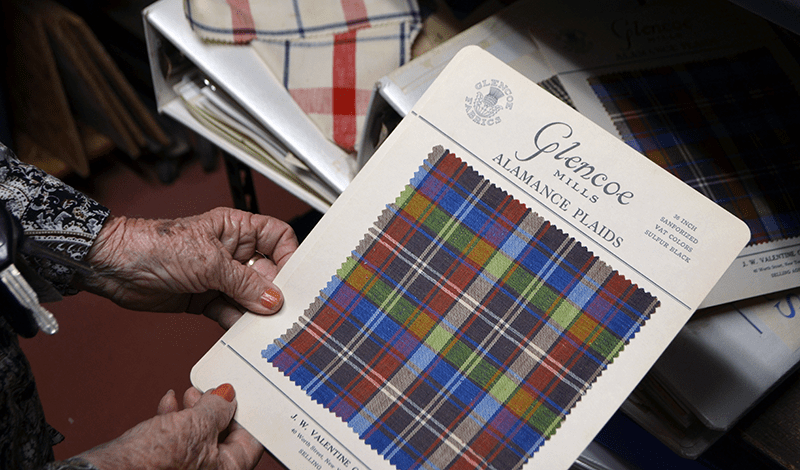
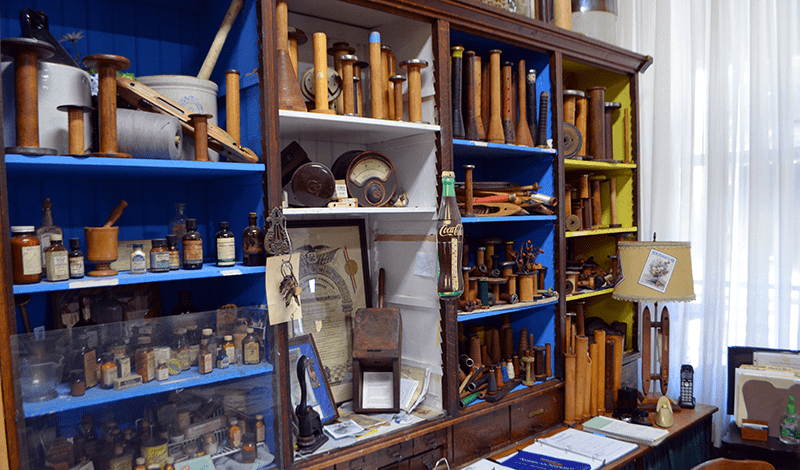
Industrial History: The Heartbeat of North Carolina
“NC State has been so good to us,” mused Museum Director Jerrie Nall as she led a small group on a tour of the fabric storage facility housed in the basement of the Textile Heritage Museum.
The story of NC State’s involvement with the Textile Heritage Museum shows the UNC System’s work to preserve history from another angle: historically significant materials don’t always have to be excavated, and the University’s efforts aren’t always delivered through research and formal partnerships. One of the University’s most significant contributions to historic preservation is simply to be a dependable resource, ready to offer support and guidance to any ambitious citizen or community organization.
Just north of Burlington sits Glencoe Cotton Mill and Mill Village, nestled on the east bank of the Haw River, whose waters once powered the machinery. Built between 1880 and 1882, Glencoe Mill was a major producer of plaid fabrics until 1954, when the mill shuttered its doors. For more than twenty years, the mill and the surrounding mill houses stood, quiet and undisturbed. Then, in 1979, the village was placed on the National Register of Historic Places.
Suddenly, investors were inspired to restore the village’s 41 mill homes. Eventually, what was once a workaday mill community was transformed into a quaint bedroom community. Still, the old mill store and the adjacent office remained empty and unused—chock full of records, samples, and catalogues, but no people. When George and Jerrie Nall purchased the Mill Owner’s House in the 1990s, they grew fascinated with the area’s history and began poking around the piles of moldering materials in the vacant buildings. It didn’t take long for them to understand that a treasure trove of historical artifacts was being left to rot and that something needed to be done salvage the materials.
“We walked through the mill and there was so much stuff just thrown on the floor. We started to fill cardboard boxes with it … anything that was paper, we moved into the office building, where at least it would be dry,” recalled Jerrie Nall.
Before too long, Sam Powell and Kathy Barry grew interested, and together, the group hatched a novel idea: to repurpose the old company store and office complex into a museum to preserve and exhibit the hodgepodge collection of materials.
“No buildings had been torn down. The houses were still here. The buildings were still intact and packed with materials. It started to occur to us that this work was important,” said Kathy Barry, the museum’s treasurer and secretary. “Everything was in place for Glencoe to be home to a museum dedicated to preserving North Carolina’s important role in textile history.”
Once the idea was sparked, their first step was to consult with the experts: the faculty at NC State’s Wilson College of Textiles. There, faculty members were intrigued by the idea of a museum situated in the heart of a completely intact mill village, and they encouraged the group to move forward with their ambitions. In 2001, the hard labor of preparing an exhibition space began.
The Glencoe crew found themselves routinely turning to NC State Professor Emeritus Gary Mock’s historical overview, A Century of Progress: The Textile Program, North Carolina State University, 1899-1999 as a font of information, and Mock himself was soon invested in the work.
“We even grabbed Gary to be on our board of directors!” chuckled Jerrie Nall.
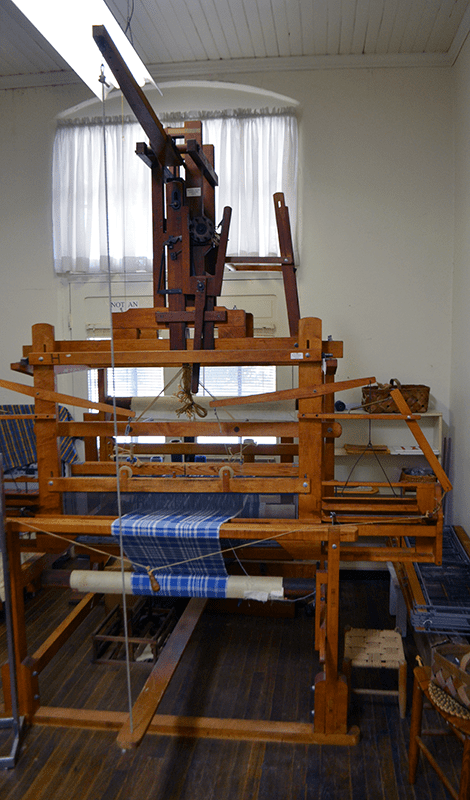
When the store and office complex was emptied, restored, and structurally sound enough to begin housing exhibits, NC State began contributing items that would complement the Glencoe materials and flesh out the museum contents: a complete exhibit on textile dyeing; an extensive collection of fabric samples and notes; and even several display stands, now used to exhibit materials. When an outside donor asked NC State what could be done with an assortment of three hundred antique bobbins and skewers, the university steered the collection to the museum.
Perhaps most notably, the university donated and assembled a massive George Wood dobby loom, which now takes up the better part of one of the museum’s wings. Professor Emeritus Alan Donaldson set up the loom to weave a typical “Alamance plaid” and, on several occasions, he ventured to Glencoe to hold demonstrations.
At various points along the way, students from NC State and UNC Greensboro donated their time and labor to help build the museum. Jerrie Nall and Kathy Barry also turned to UNC-Chapel Hill’s Wilson Library to locate important Glencoe Mill records.
Today, the museum is a firmly established institution, attracting visitors from across the country. Some have come from as far away as Mexico. The attraction has been so successful that Alamance County Recreation and Parks is gradually assuming control of the museum—a clear sign that what started as a labor of love eighteen years ago is becoming an increasingly important part of the region’s landscape.

With colorfully restored mill houses, hiking trails along the river, and the old mill structure ripe to be transformed a grand, multi-use facility, Glencoe Mill Village is set to become a vibrant local cultural hub in the same vein as Saxapahaw near Chapel Hill or Revolution Mill in Greensboro. Alamance County Parks Superintendent John Guss sees the museum as playing a important role leading this transformation.
“When Alamance County started the transition to assume control of the museum, one of the first things we did was expand the museum’s hours to 40 hours a week, modelled after other North Carolina historical sites. Just within the last six months, this has doubled our visitation, and it indicates that the museum will be a real draw to this area going forward,” he explained.
More importantly, Guss sees the museum capturing a vital aspect of North Carolina’s history that rarely gets thorough treatment: the role of industry.
“Across the state, there are very few museums dedicated to industry. There are forts, farms, and battlefields we can visit, but not much that’s specifically dedicated to industry … and industry is the heart and soul of America,” he said. “The amount of textiles coming out of North Carolina is mind-blowing. Without the textile industry, the state wouldn’t be what it is today. How can we appreciate our state’s history if we don’t know the history of its industries?”
Jerrie Nall shares this sentiment adamantly.
“We’ve got to preserve this history, because how will the future know what it was? Those in our state’s future would have no idea if this past wasn’t preserved,” she offered, with unwavering passion.
History, Heading into the Future
Visitors to the Textile Heritage Museum will find plenty of relics and curiosities from the past, many of them donated by NC State. But visitors will also find a number of high-tech fabrics lining the walls: a Kevlar t-shirt designed for astronauts; a protective ice-hockey uniform; a flame retardant firefighting outfit … all evidence that North Carolina’s textile history didn’t come to a halt in 1954 when Glencoe Mill shuttered its doors, or in the 1980s, when the industry began to undergo radical change. Understanding textile history is to recognize that North Carolina textiles continue to make history.
“On my most recent visit to the Textile Heritage Museum, I noticed that many of the family names featured there were the same as some of my former students. The continuum was there on display,” said Dr. George Hodge, associate professor in the Wilson College Department of Textile Engineering, Chemistry & Science. “Future textile products, processes, and enterprises will be rooted in the industry’s past. As our students work to create what’s next, they will also need to better understand our textile history. For this reason alone, the Textile Heritage Museum is a wonderful resource for us and for North Carolina.”
Throughout the state, UNC System efforts remind North Carolinians that historical research might require careful work with objects that have been buried and nearly forgotten, but understanding history requires something much nuanced and complex: recognizing the ways in which the past exerts such force that it shapes North Carolina’s present … and its future.
